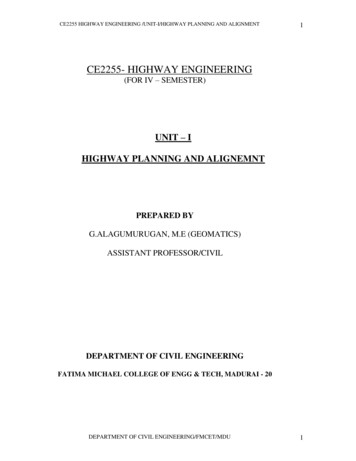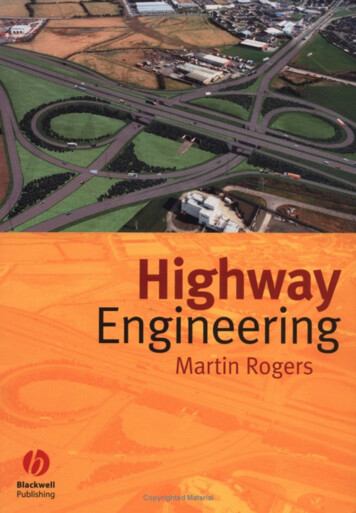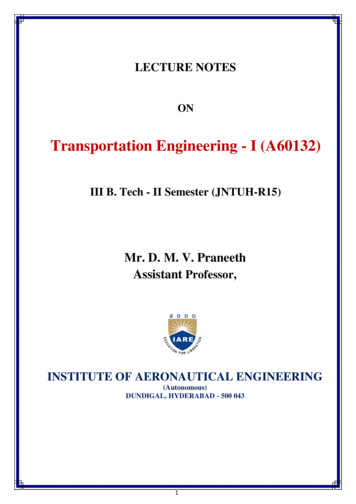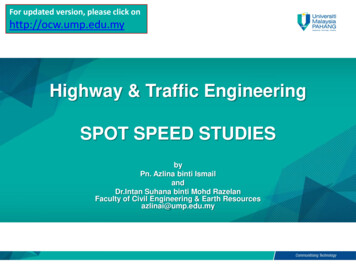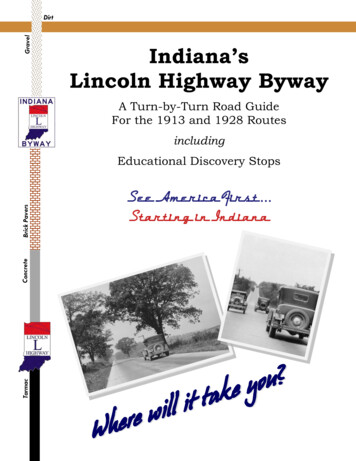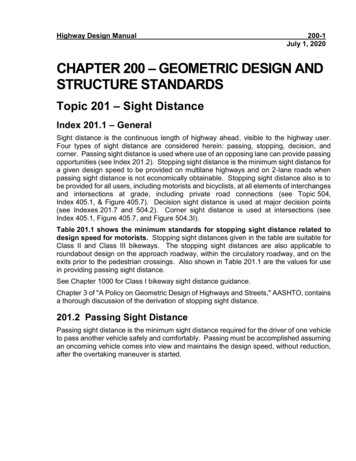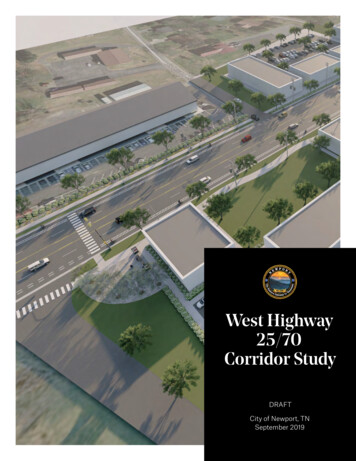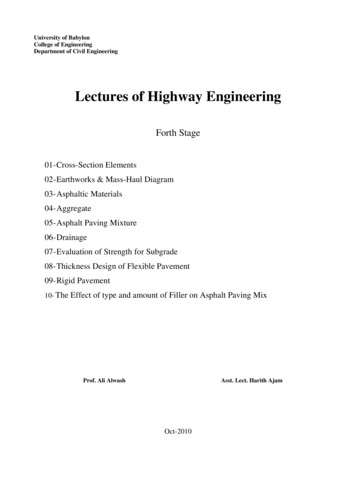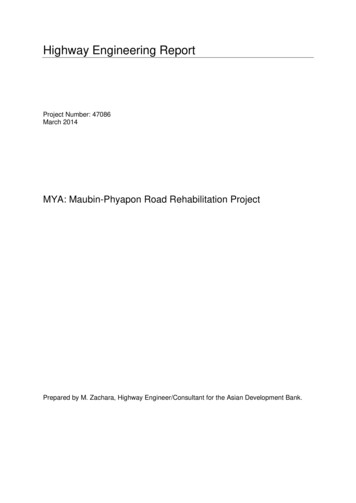
Transcription
Highway Engineering ReportProject Number: 47086March 2014MYA: Maubin-Phyapon Road Rehabilitation ProjectPrepared by M. Zachara, Highway Engineer/Consultant for the Asian Development Bank.
CURRENCY EQUIVALENTS(as of 15 March 2014)Currency unit–Kyat (K)K1.00 1.00 ian Development Bankannual average daily trafficAmerican Association of State Highway and TransportationOfficialsbill of quantitiesCalifornia bearing ratiocentimeterconstruction supervision consultantdynamic core penetrometerequivalent single axle loadJapan International Cooperation Agencykilometermetersquare metercubic metermaximum dry densitymillimeterMinistry of Post and TelecommunicationsMinistry of Constructionoptical fiber cableoptimum moisture contentplasticity indexPublic WorksNOTESIn this report, " " refers to US dollars unless otherwise stated.
TABLE OF CONTENTSPageEXECUTIVE y of Key Project IssuesII.Road Sector in MyanmarA.IntroductionB.Road ManagementC.National Road NetworkD.Other Road Project InitiativesE.Construction Industry CapabilityIII.Project RoadA.GeneralB.Applicable Road StandardsC.Project Road for Government FundingD.Project Road DetailsE.Traffic CharacteristicsF.Pavement Performance ProblemsG.Existing BridgesH.Road Construction IssuesIV.Proposed Road and Bridge DesignA.GeneralB.Road AlignmentC.Road Safety ImprovementsD.Road Side Services and Other FacilitiesE.Bridges and DrainageF.Pavement Thickness DesignV.Engineering Proposals and RecommendationsA.GeneralB.Engineering InitiativesVI.Specifications and DrawingsA.OverviewB.Design in Construction PhaseC.Lack of Familiarity with International SpecificationsVII.Cost EstimateA.GeneralB.Key Unit Rates.C.Cost By Road SectionVIII. Road MaintenanceA.GeneralB.Road Network PreservationC.Road Maintenance.D.Road Maintenance and the Project 363639393940414141414242424243
Appendix AAppendix BAppendix CAppendix DAppendix EAppendix FAppendix GAppendix HRoad Condition Assessment SurveyGeotechnical Investigations and Material TestingRoad Works Needs AssessmentMOC Road Condition Assessment Ayeyarwaddy RegionPublic Works Organization StructureOo Yin Chaung Bridge – General ArrangementMeetingsBridge & Major Structures Condition and Possible Works NeedsFigure III-1:Figure IV-1:Figure IV-3:Project Road Pavement Failures24Typical Cross Section where New Alignment has been offset byapproximately 3 m and existing formation is narrow33Typical Cross Section where New Alignment has been offset by 0 to 1 m andexisting formation is wider34Typical Cross Section35Table II-1:Table II-2:Table II-3:Table II-4:Table II-5:Table II-6:Table II-7:Table II-8:Table II-9:Table II-10:Table III-1:Table III-2:Table III-3:Table III-4:Table III-5:Table III-6:Table III-7:Table III-8:Table III-9:Table III-10:Table III-11:Table III-12:Table III-13:Table III-14:Table III-15:Table IV-1:Table IV-2:Table IV-3:Table V-1:Table V-2:Table VII-1:Table VII-2:Road Network LengthRoad Network Length, March 2012 (km)Myanmar Registered VehicleMyanmar Road Accident Statistics (2006–2012)Accident Numbers by Vehicle TypeAllowable Loads by Vehicle TypeRoad Budget for Roads Managed by Public Works (in million Kyats)Costs/kilometer of Public Works Road Network ( million)Ayeyarwaddy Road Network Budget (in million Kyat)Costs per Kilometer of Ayeyarwaddy Road Network ( /km)Myanmar Road StandardsProposed Standards by Road SectionTotal Expenditure on Project Road (in million kyat)Expenditure/Kilometer on Project Road ( )Summary of 2003 and 2006 Geotechnical InvestigationsSummary of 2013 Geotechnical Investigations (Roadside)Summary of 2013 Geotechnical Investigations (Existing Road)Summary of 2013 Construction Material InvestigationsBase and Surfacing Test results and Specification RequirementsSummary of Rainfall Statistics (mm of rain recorded)Major Cyclone EventsAADT Volumes 2013Calculation Steps to Determine Traffic Design LoadIndicative Pavement Design Loading (million ESAL)Road Accident s Maubin to Phyapon Road 2012/2103Bridges Where Cable is to be RelocatedServices that Need to be RelocatedFlexible Pavement ThicknessCrushed Rock Base Course Grading RequirementsSubbase Grading RequirementsKey Works, Material and Equipment Unit RatesProject and Road Section Costs ( million)Figure 20212222232328293237374141
EXECUTIVE SUMMARYINTRODUCTION1.The proposed road project between Maubin and Phyapon will include thereconstruction and widening the 54.45 kilometer (km) length of road (including 2 sectionsthrough urban areas) and also bridge and drainage structure improvements. Althoughseemingly straight forward, the road works are complicated by the presence of poor groundconditions, standing water throughout most of the year, but especially during the wet season,the presence of a major underground communication cable in the road formation and thelack of readily available and appropriate construction material. The need to widen the roadand build over soft ground, presently used for rice growing will also mean that a part of thewidened road embankment is likely to settle, even though every effort will be made tominimize this by programming the construction works so that traffic uses the widenedportions and accelerates the settlement before the final pavement layers are constructed.Due to the possibility of settlement, the adopted surfacing is asphalt concrete as preferred bythe Ministry of Construction (MOC).A.Road Construction2.The presence of the underground cable has required the road to be moved laterallyby 3.5 meters (m) and, thus, constructing the widened embankment over a soft and wetground for at least the first 25 km of the road’s length and for lesser widths along most of theremaining length. The proposed road formation width for the rural road sections is 11.4 m, ofwhich 10.2 m will be surfaced, including 1.8 m for each shoulder. The urban sections will bea 7 m paved surface with gravel shoulders 1of varying width.3.The road height will be raised by an average of 35 centimeters (cm) to ensure thatthe road has additional clearance over flood water and to allow the reconstruction of the roadembankment. Because of the short nature of the study and limited survey work, theconstruction supervision consultant will establish the final road levels after a detailed surveyis completed in the first months of the contract.4.As a horizontal shift in the road alignment is not possible at the more significantbridges and the road will need to return to the existing centerline at these structures, it will benecessary to relocate the communication cable on the approach and departure of bridgesand 2 cable road crossing locations. The Ministry of Post and Telecommunication wereconsulted on this and have agreed, in principle, to the relocation. In addition to theserelocations, it will also be necessary to relocate electricity lines (including an 11 km section)and a few telecommunication poles along the road.5.The lack of suitable material in the project area, even for common fill, means thatmost of the required construction materials have to be imported. To lessen the cost of theroad works, maximum use will be made of local construction materials by improving theirproperties by using lime and mixing them with other materials. The contractors will,therefore, have to have suitable equipment that includes an in-situ stabilization equipmentand/or material mixing plant capable of handling and blending 4 different materials includingthe modification/stabilizing agent. The contractors will also, of course, need to develop sitesfor the blending/mixing operation and for stockpiling construction materials, prior to thembeing placed on the road.1The new road surface will be at or within 100 millimeters of the existing paved road surface. The gravel is,therefore, used to make sure that there is no drop off at the edge of the paved surface. It is understood that themunicipal authorizes will construct concrete shoulders or pathways adjacent to the proposed concretepavement at a later date.
iiB.Bridge Works6.The structural elements of the project will include the possible widening of 2 simpleshort span slab bridges, 2 the upgrading of the single lane 3-span Oo Yin Chaung bridge, thereplacement of the Kyee Chaung bridge (13 m), and the possible widening and/orreplacement of a 16 m bridge in Kyaiklat Township over Pagoda creek. 3 The upgradingworks for the Oo Yin Chaung bridge will include the widening of the existing abutments andthe construction of a 2 lane superstructure. Structural works at other locations will includethe raising of wing, head, and abutment return walls, and the lengthening of many of these. Itwill also be necessary to lengthen 3 pipe culverts and construct headwalls, and possiblycarry out other corrective tasks which could not be assessed as the culverts wereunderwater at the time of writing this report.C.Pavements7.Two types of pavements are proposed, namely flexible pavements for the rural roadsections and rigid pavements for the two urban sections, in Kyaiklat and Phyaponrespectively. The designs were based on TRL Road Note 31 for the flexible pavement andon the American Association of State Highway and Transportation Officials 4 for the rigidpavements. The adopted design traffic load was 7 million equivalent single axle load (ESAL)over a 20 year design life. This was based on current traffic levels, and the assumptions that40% of trucks are unloaded and that loaded trucks are 15% overloaded. Growth in ESALover the project’s design life has been assumed, based on traffic studies that were part ofthis technical assistance’s scope, to be 13.2% per annum.8.The designs were based on past soils studies and a short program of testing thatwas carried out by the MOC Road Research Laboratory. The August/September 2013investigations and testing showed that subgrade conditions were poor with soaked Californiabearing ratio (CBR) values as low as 1% but typically 2% to 3%. Moisture conditions in thesubgrade were 2 to 2.5 time the optimum moisture content with many locations recording amoisture content greater than 30%, which is greater than would occur after 4 days ofsoaking and is more likely to be represented by samples soaked for 7days, where local soilsamples recorded CBR values of 1%. The high moisture content environment is, it isbelieved, the result of poor pavement structure drainage in the existing pavements which areconstructed as “boxed” pavement structures which are known to retain water and lead tosaturated road conditions.9.Given these conditions it is proposed that an improved fill and subgrade layer, bothwith CBR values of at least 5% underlie the pavement structure itself. The proposedpavement structure will also include improved pavement structure drainage and surfacedshoulders that are designed to stop water wetting up the pavement under the traffic lanes.This should ensure that embankment moisture conditions are significantly improved.10.While a number of flexible pavement types were considered including the use ofcement stabilized layers and an asphalt concrete surfacing the proposed pavement andupper embankment levels include a lime modified improved fill, a sand/soil blended234These small slab bridges will not need to be widened if Myanmar Post and Telecommunication confirm theirunofficial advice that they would be able to relocated the optical fiber cable at the 2 bridges.PW were in the process of carrying out investigations/design of the Kyaiklat township bridge at the time ofwriting this report.The American Association of State Highway and Transportation Officials (AASHTO) is a standards settingbody which publishes specifications, test protocols and guidelines which are used in highway design andconstruction throughout the United States. Despite its name, the association represents not only highways butair, rail, water, and public transportation as well.
iiisubgrade (both with a minimum CBR of 5%), a sand/soil/river gravel subbase, a densegraded crushed rock base and an asphalt concrete surface. Total cost of the project roadwith asphalt concrete surfacing (including concrete pavement in the urban sections) and theupgrading and/or replacement of 3 bridges is 54.1 million.D.Road Maintenance11.The proposed project road includes features that should lead to good ride quality forclose to 15 years with rehabilitation required after 20 years, possibly even 25 years. This will,however, only be possible if there is a change in the road management philosophy andapproach in Myanmar, with a move away from the repair and reconstruction mentality to oneof maintenance, preservation and rehabilitation. The focus should be on extending pavementlife and delaying the need for major works.12.The present strategy is a high cost, low road performance strategy that cannot becontinued if the Government of Myanmar is to improve the condition of the country’s roadnetwork. No country can afford to achieve the required improvements, using the currentstrategy, with all leading road authorities working to extend the life and performance of roadsand delaying the need for all major work tasks, including periodic maintenance andreconstruction, for as long as possible. Significant funds have been directed internationally toresearch projects that would deliver improved road performance and this has resulted in theadoption of new materials, techniques and new road management strategies, such as thepreventive maintenance strategies that have extended pavement lives by 5 to 10 yearsbeyond their design lives.13.For the project road, this will mean resurfacing (sprayed seal) the road inapproximately 6 years and again in 12 years, after construction, with funds also allocated forannual routine maintenance and some minor repairs throughout the pavement’s life. Thefocus of the maintenance should be prevention first, with action being taken within days andweeks of defect identification rather than months and years. This change in thinking willpossibly require a change in the way maintenance work needs are identified and funded withMOC/PW District Offices having the authority and the ability to take action when needed.
I.A.INTRODUCTIONGeneral1.This report sets out the findings and engineering design details of the study into therehabilitation of the road between Maubin and Phyapon. The proposed works, namely thereconstruction and widening the 54.45 kilometer (km) length of road (including 2 sectionsthrough urban areas), although seemingly straight forward, are made more complexbecause of the poor ground conditions, the presence of water throughout most of the year,but especially during the wet season, the presence of a major underground communicationcable in the road formation, and the lack of readily available and appropriate constructionmaterial.2.The presence of the underground cable has required the road to be moved by anaverage of 3 meters (m), which means constructing and widened the embankment over asoft and wet ground for at least the first 29 km of the road’s length. This could cause a delayin construction as ground conditions will need to dry out before the embankment foundationscan be prepared to accept the widened embankment. Land owners will need to be asked notto flood the field where the widening is to take place in the 3 months preceding thefoundation preparation.3.The structural elements of the project will include the possible widening of 2 simpleshort span slab bridges 5, the upgrading of the single lane 3 span Oo Yin Chaung bridge, thereplacement of the Kyee Chaung bridge (13 m) and the widening and/or replacement of a 16m bridge in Kyaiklat Township over Pagoda creek 6. The upgrading works for the Oo YinChaung Bridge will include the widening of the existing abutments and the construction of a2 lane superstructure.4.Other structural works include the raising of wing, head, and abutment return walls,and the lengthening of many of these. It will also be necessary to lengthen 3 pipe culvertsand construct headwalls, and possibly carry out other corrective tasks which could not beassessed as the culverts were underwater at the time of writing this report.5.The lack of suitable material, even for common fill, means that most of the requiredconstruction materials have to be imported, some from long distances. To lessen the cost ofthe road works, maximum use is to be made of local materials. Materials to be used include:(i)(ii)(iii)(iv)(v)(vi)B.silty sand from the river – road fill;lime stabilized soil and silty sand – improved fill (California bearing ratio[CBR] of 5%);blended soil/silty sand – subgrade;shingle/sand/soil blend or a stabilized sand soil blend – subbase;dense graded crushed rock (blend of crushed dust, 6 millimeter (mm) plusand 10 mm to 20 mm crushed rock fractions) – base; andcrushed rock aggregate – asphalt concrete surfacing.Background6.The objective of the project is to develop proposals, designs, and bidding documentsfor the rehabilitation of the Maubin to Phyapon Road, which is a priority link in the56These small slab bridges will not need to be widened if Myanmar Post and Telecommunication confirm theirunofficial advice that they would be able to relocated the optical fiber cable at the 2 bridges.PW were in the process of carrying out investigations/design of the Kyaiklat township bridge at the time ofwriting this report.
2Government's key infrastructure development agenda as it will improve connectivity to therich agricultural Ayeyarwaddy Delta, and, in so doing, support inclusive economic growth.The 55 km section of road is to be improved to an appropriate 2 lane standard withappropriate width shoulders, suitable for all standard highway traffic.7.The study document covers engineering, safety, economic, social, gender, andenvironmental aspects and engineering studies, namely, condition assessment; work needsassessments, road standards, pavement design, cost estimates, bidding documents and animplementation plan. The related economic study, documented in a separate report, hasconducted traffic surveys and assessed the economic feasibility of the project. Theaccompanying financial analysis also did an assessment of the financial managementsystems and capabilities of the implementing agency (Public Works [PW]).8.The project also includes social impacts, resettlement and environmentalcomponents, each of which have prepared reports, namely, an initial environmentalexamination, poverty and social assessment, resettlement plans, and a stakeholdercommunication strategy. These have included surveys and consultation with communitiesalong the road. These reports are included in separate volumes.9.The proposed road project is part of the Ministry of Construction (MOC) program andwill be implemented by PW.C.Summary of Key Project Issues10.The issues and observations that will impact the engineering details andimplementation arrangements for the road project are detailed below. Most relate to the siteconditions, availability of suitable materials, capability of local suppliers to supply on time,relocation of road side services, and sprayed sealing.11.The issues that will and/or may impact on the implementation of the project include:(i)(ii)(iii)Construction material (embankment and subbase materials) availability. Theconstruction solutions that have been identified will require the processing ofa large quantity of materials. The process will include blending of materialsand, in some instances, adding cement or lime to further improve the materialproperties. It will also include crushing of existing pavement materialssalvaged from the existing road. All these tasks will require an experiencedcontractor and require the development of facilities for offloading materialsdelivered by water and sites for the storage and processing (blending) ofmaterials. The study has not been able to establish the capacity of the currentsuppliers to supply the required materials at the rate required. The materialsinitially required are silty sands that will be won from the river;Ground conditions of the area that will form the foundation for any roadwidening and those parts of the existing embankment not directly under theexisting traffic lanes, will, although compacted to the extent possible, settle ata different rate to the part of the embankment under the traffic lanes.Differential settlement is, therefore, likely. This is especially so in those areaswhere it may not be possible to dry out (or even to remove the watercompletely) before the widened embankment is constructed;Transport of higher quality pavement materials. This will be done by rivertransport and by road. Reasonably priced (for Myanmar) crushed rock isavailable from the Mandalay region. Transport from this area is, however,limited after the end of February, except in small quantities, because of lowlevels in the Ayeyarwaddy River. While alternate sources can be sourcedfrom Moulmyaing in Mon State (delivered by sea) the cost is reported to be 20
3(iv)(v)(vi)(vii)(viii)(ix)78to 30% higher. Other sources located to the west of the project road anddelivered by road from Myaung Mya are weathered rock of subbase quality(high Los Angeles abrasion) only. As crushed rock will only be required forthe base and surfacing layers, it would not normally be required for at least 9to 12 months after works commencement, although this will depend on howthe contractor chooses to do the construction. 7 The effect of possible delayscould be mitigated by bringing in materials over a longer period and stockpiling after blending (areas would need to be prepared for both the blendingand stock piling) close to the road so that the material ready when needed;Supply of crushed rock. Most crushing operations are reportedly small andthere is, therefore, likely to be a variation in quality and the rate of productionof required sizes (limited, as is the supply), given the competition from otherprojects. Only 1 large crusher (350 tons/hour) has been identified to-date (inMon State). The above situation is complicated due the availability ofexplosives, which are controlled by the Ministry of Home Affairs and theMinistry of Defense. Requests for explosives need to be made 1 year inadvance, although some contractors hold reserves that are stored at theMinistry of Defense installations. 8 Given the above, pavement options thatminimize the use of crushed materials have been explored;Underground communications cable location is not well defined. Distancefrom the road centerline varies, as does the side on which it is located. Thepositions recorded by PW district offices and shown on the contract drawingswill be indicative only. Although the road will be moved to one side by 1 m to4 m, there are 3 locations where the cable switches from east to west of theroad centerline and vice versa. There will, therefore, be lengths of road wherethe contractor will have to work around the cable. The contract documents willrequire the contractor to identify the exact location of the cable before anyexcavations are started and require that Myanmar Post andTelecommunications (MPT) people be on site when road works are beingcarried out where the cable crosses the road;Relocating of communication fiber cable at medium to large bridges (8bridges and at 3 of the points where the cable crosses the road). MPT hasinspected the nominated locations and are finalizing the estimates. MPT willseek funds from the Government to do the necessary work. MOC is toconfirm the locations, and the timing for moving the cable before MPT startthis work. The work would need to be completed before the end of December2014;Contractors will have to have equipment for mixing and/or blendingembankment and pavement materials. Some of the work can be done withstabilizing equipment and some will require a mixing plant. The contractdocuments list this equipment.Asphalt Concrete equipment (batch plant, paver and rollers) will need to be ofa quality that will produce the required seal quality. The equipment shouldideally come with a certificate of recent inspection and calibration, althoughthis is not always possible. The equipment will be checked and calibrated onsite and tests seals completed before being allowed on the road;Relocation of other service such as power lines and some above groundtelecommunication cables will be needed. A list of locations will be includedon the drawings for action by PW.Complete the road to subbase level for all or most of the contracted road section and then start of the base andcomplete the seal or he could choose to complete section of say 5 to 10 kilometers, including the base layerand seal.Explosives are delivered to the quarry site, escorted by the army or police, whose costs are covered by thequarry operator. A tax (a form of royalty) is also paid for the material carried away from the quarry sites.
4II.A.ROAD SECTOR IN MYANMARIntroduction12.The road sector is in many respects a description of the PW as they, until recentlywere responsible for all road construction and maintenance. While this continues to be thecase for all public roads some private sector consultants have been carrying outinvestigations and design for private sector developments. Those consultants include somestandalone consultancies and consulting firms that are part of a large multi-faceteddevelopment groups. The same applies to construction with most of the contractingcompanies being a part of a larger development group.13.Although independent of the government, when involved in private sector work, boththe contractors and consultants follow methods and procedures that are essentially those ofPW. Estimating procedures, specifications, standard drawings and the solutions proposedfor road works are essentially those of the PW. The introduction of new methods as evidentin the building industry, have yet to be seen in road works.B.Road Management1.General14.MOC is responsible for the construction and maintenance of approximately 39,000km of national, regional, and state roads. It is also responsible for airport development andmaintenance, for government building, and housing development and maintenance.2.Ministry of Construction Structure15.The MOC is headed by a Union Minister and supported a Deputy Minister who, withtheir staff oversee the operations of the 2 departments as follows:(i)(ii)Human Settlement and Housing Development Department, headed by aDirector General; andPW, headed by a Managing Director.a.Public Works (PW)i.PW Structure16.PW is an enterprise that is managed by a management board consisting of theManaging Director and 4 deputy Managing Directors. There are 8 Chief Engineers and 13deputy chief engineers at the head office in Nay Pyi Taw. There are also 4 supportingdivisions headed by General Managers, who are non-technical senior administrators (pleaserefer to Appendix E).17.There are 17 Regional and State offices headed by a superintending engineer and66 District Offices headed by an Executive Engineer.18.While the district offices are shown to report to the Repair and MaintenanceDepartment in the organization chart, they also report to the Works Department as eachdistrict office also carries out capital works.ii.19.PW ResponsibilityPW is responsible for the development and maintenance of road, bridges, airports
5and related building infrastructure as well as building and related services for governmentadministration, education, health, transportation and industry.iii.Public Works Operations in the Project Area20.The project road is located in 2 Districts, namely Maubin and Phyapon. Thirteenkilometers of the road are in Maubin District and 42 kilometers in Phyapon District. PW haveoffices in both districts.21.There is also a Regional Office in Pathein (Ayeyarwaddy Region), located well to thewest of project road and 2 special bridge construction units based in the region.22.The two PW District Offices are presently responsible for all works on the projectroad and will of course take on the same responsibility after construction and the defectliability period.23.The district offices are responsible for the development of road rehabilitation andmaintenance proposals including cost estimates and also for implementing the resultingapproved works program. The funds for approved works are transferred directly into theDistrict Office bank by PW in Nay Pyi Taw.C.National Road Networka.National Road Network Characteristicsi.Road Lengths24.The total formal road network length has been growing an average annual rate ofapproximately 6% since 2004, as indicated in Table II-1 below. The network managed by theMOC has grown by an average of approximately 3.5% since 2004.25.As will be noted the length of paved road network is around 22% of the total roadnetwork and 45% for the PW managed road network.26.Table II.2 summarizes the road characteristics by road class and surface type as atMarch 2012. At that time, 45% of the MOC administered road network was paved. Thepercentage of paved roads in Ayeyarwaddy region is 42% which is slightly below the PWmanaged network average.27.The paved road percentage for the Union (National) Highway network was 63% whilethat for the regional and state roads was only 28%.Year20042005200620072008200920102011Table II-1: Road Network LengthResponsibility of MOC (km)Total Road NetworkTotalPavedTotalPavedLengthLength% PavedLengthLength% 142,39530,87921.7km kilometer, MOC Ministry of Construction.Source: PW.
628.The percentage
Highway Engineering Report . Project Number: 47086 . March 2014 . MYA: Maubin-Phyapon Road Rehabilitation Project . Prepared by M. Zachara, Hi
